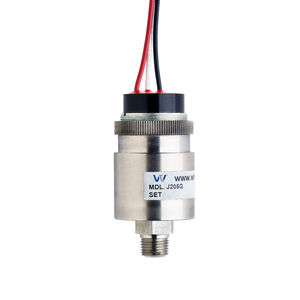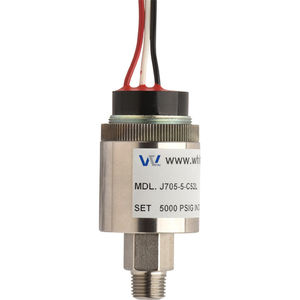
- Detection - Measurement
- Flow, Pressure and Level Measurements
- Diaphragm pressure switch
- Whitman Controls Corporation
Diaphragm pressure switch P95 relativefor liquidsstainless steel

Add to favorites
Compare this product
Characteristics
- Technology
- diaphragm
- Pressure type
- relative
- Fluid
- for liquids
- Material
- stainless steel
- Other characteristics
- high-pressure
- Pressure range
Max.: 4,000 psi
Min.: 0.75 psi
- Process temperature
Max.: 257 °F
(125 °C)Min.: -40 °F
(-40 °C)
Description
The Whitman Controls P95 Severe Environment Pressure switches are built to operate in harsh conditions and are typically used in vehicle applications both off road and on. As these switches are NEMA 6 rated, they are weather proof and briefly submersible. Resiliency in high pres¬sure conditions is the key differentiator relative to its P90 sister switch, with the ability to withstand hydraulic spikes to 4,000 psig. Ideal use is on log skidders, tractors, cranes and numerous other applications where pressure spikes, shock, vibration and weather are of primary concern.
Key Features:
• Ability to withstand hydraulic spikes to 4,000 psig
• Shock resistant up to 150G
• Vibration durability of 10Hz to
2,000Hz @ 10G’s
• Water resistant up to 1,000 PSIG high pressure spray
• Cold Storage up to -67oF (-55oF)
• NEMA 6 Rated: Weather-proof and briefly submersible
• Set point options: Factory set to
customer specification, non-
adjustable
•Extensive operating temperature range
Specifications:
• Set point range: 0.75 to 400 PSIG
• Max System pressure: 4000 PSIG
• Temperature range: -40oF to +257oF (-40oC to +125oC)
• Amps: 1-11 Amps Max
• Sensor Element: Diaphragm
• Weight: 7oz (varies with electrical interface selection)
• Cycling: Not to exceed 20 CPM
• Wetted Parts:
Diaphragm: Viton
Lower Body: 303 Stainless steel
Standard Thread: ⅛” NPT
Optional Threads: 12-20 SAE, other fittings available in quantities
Catalogs
Other Whitman Controls Corporation products
Pressure Switches
Related Searches
- Level limit switch
- Pressure gauge
- Level probe
- Liquid level limit switch
- Liquid level probe
- Analog pressure indicator
- Pressure switch
- Mechanical pressure switch
- Float level switch
- Threaded pressure indicator
- Stainless steel level limit switch
- Dial pressure indicator
- Waterproof pressure switch
- Bourdon tube pressure gauge
- Diaphragm pressure switch
- Tank level detector
- Adjustable pressure switch
- Plastic level switch
- Magnetic float level switch
- Liquid pressure switch
*Prices are pre-tax. They exclude delivery charges and customs duties and do not include additional charges for installation or activation options. Prices are indicative only and may vary by country, with changes to the cost of raw materials and exchange rates.

















